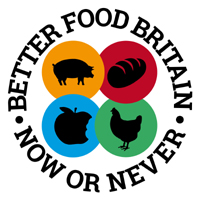Blogs • Good Food Trade Campaign
We must uphold high standards for regulation of food additives
Following campaigning by parents and health professionals, the UK has made progress on removing potentially harmful additives from children's food. Now that the UK is leaving the EU and new trade deals are on the cards, we need to ensure these helpful policies and standards continue to be supported in the UK, says Annie Seeley of Action on Additives.
 With the growing popularity of processed foods over recent decades, food labels reveal that we have been eating a cocktail of food additives. Sometimes known as "E-numbers" because of their identification by an EU number in the ingredients list, such food ingredients have undergone assessments by expert committees, organised by EU-based institutions and scientific assessments, and evaluated as safe to eat. The UK has contributed extensively to this process, sometimes taking a leadership role.
With the growing popularity of processed foods over recent decades, food labels reveal that we have been eating a cocktail of food additives. Sometimes known as "E-numbers" because of their identification by an EU number in the ingredients list, such food ingredients have undergone assessments by expert committees, organised by EU-based institutions and scientific assessments, and evaluated as safe to eat. The UK has contributed extensively to this process, sometimes taking a leadership role.
What will happen to the regulation of harmful additives when the UK leaves the European Union? And is there potential for such substances to increase in our food if international trade deals allow less regulated products to enter the UK market? Parents are rightly concerned to find out what checks and balances will be put in place by the UK to maintain food quality, and to inform and protect consumers. Will the UK government maintain and strengthen the current system and not allow standards to slip backwards? Will UK institutions have the expertise and capacity to undertake safety analyses independently? Many such questions remain unresolved.
Please Tweet: Don't let the Repeal Bill mean Bad Food Britain. Write to your MP now to protect good food standards! http://bit.ly/2pRPCvs @fixrepealbill
Regulation of additives: the story so far
One of the key successes for families across the EU - including in the UK - has been the reduction in the use of some colours linked to hyperactivity in children, and the requirement for a warning label on foods that contain them.
Back in 2002, research by the UK’s Asthma & Allergy Research Centre, working on behalf of the UK government’s Food Standards Agency (FSA) found that “significant changes in children’s hyperactive behaviour could be produced by the removal of colourings and additives from their diet”. The additives, tested on toddlers, were the artificial food colourings Tartrazine (E102), Qunioline Yellow (E104), Sunset Yellow (E110), Carmoisine (E122), and Ponceau 4R (E124), and the preservative Sodium Benzoate (E211), given as a cocktail in a single drink. The test dose of colourings administered in the trial was well below levels permitted in children's foods and drinks. For the preservative, the test dose was equal to the permitted level.
An independent charity, The Food Commission publicised the research in The Food Magazine, and the story was picked up by national press and media, putting pressure on the FSA and the food industry. However, industry representatives called for more research, claiming the study was not robust enough. The FSA commissioned further research.
Fast forward to 2007 and the new study, commissioned by the FSA and carried out by Southampton University, confirmed the findings of the first: certain food colourings and a preservative may have an effect on some children’s behaviour.
The research found that there was a possible link between consumption of these additives and increased hyperactive behavior. The UK's FSA proposed a voluntary ban on the six colours included in the study and one year later in 2008 UK ministers accepted the proposal, with a plan to work with industry to remove them by 2009. Earlier in the same year the European Parliament voted in favour of labelling foods containing the six food colours Tartrazine (E102), Quinoline Yellow (E104), Sunset Yellow (E110), Carmoisine (E122), Ponceau 4R (E124) and Allura Red (E129) with the words “may have an adverse effect on activity and attention in children”.
What can we learn?
The story of the 'Southampton Six' (the nickname for the cocktail of additives of particular concern to parents) illustrates the need for good scientific assessments and independent institutions such as the FSA, as well as the importance of labelling regulations being set by government. While major retailers and manufacturers have replaced the 'Southampton Six' colours with natural colours such as pumpkin, beetroot and spirulina, the 'Southampton Six' are still widely used in confectionery, drinks and other foods, particularly those imported from countries such as the USA and South Africa, where there may be lower public awareness and fewer labelling or compositional regulations.
Future international trade deals between the UK and countries outside Europe, once the UK has left the EU, could open the flood gates to foods with additives that have not been stringently tested through EU processes, nor clearly labelled with a warning, and it is unclear how the UK might regulate this. There is still much work to be done to inform consumers and protect children from harmful additives and those that may trigger hyperactive episodes. Losing the current protections and the successes gained over the past 10 years would be a backward step for family health and well-being.
This Brexit Brief is by Annie Seeley, Senior Researcher, Action on Additives
Additional material provided by Kath Dalmeny, Chief Executive, Sustain: The alliance for better food and farming
Photo credit: Annie Seeley
What needs to happen?
To promote a healthy approach to regulation of food additives, the Government must:
- Commit to continuing to regulate food additives in a way that supports good health and public trust.
- Ensure that high standards of food regulation - including additives - are not 'sold off' or weakened through new international trade deals. All trade deals, as part of the new Trade Bill, should be required to be open to public and parliamentary scrutiny before they are agreed.
To protect the health and well-being of children and parents, the Repeal Bill must also:
- Confirm that any substantive changes to UK policies and standards, before or after Brexit, must be made by primary legislation only, giving a full and proper role to parliamentary scrutiny, on behalf of UK citizens and, where relevant, scrutiny by devolved administrations in Scotland, Wales and Northern Ireland.
- Limit delegated powers, including Henry VIII powers, strictly to the purpose of faithful conversion, with a statement on the face of the bill that powers cannot be used for purposes beyond faithful conversion.
- Set out new arrangements for good food governance, to ensure the continued provision of monitoring, measuring, ensuring proper implementation, checking compliance, enforcing, reviewing and reporting, co-ordinating and publicising. The Repeal Bill must also set out requirements for new or upgraded UK governance institutions to have adequate resources, appropriate independence, relevant expertise and sufficient powers. This is necessary to ensure proper regulation of additives, as well as high standards for food safety, baby food, animal and plant health and animal welfare, food traceability, effective action against food fraud and overuse of farm antibiotics, and high standards of environmental protection.
Sustain has joined the new Fix the Bill alliance, coordinated by Unlock Democracy, to press for better policy outcomes from the Repeal Bill, for people and the planet - health, welfare and sustainability. Sign up your organisation for news or to get involved at www.repealbill.org and follow on Twitter at @fixrepealbill
The technical bit
In order to protect the safety and quality standards for food additives the Repeal Bill must…
1. Effectively transpose all relevant legislation into UK law
Food improvement agents
This includes legislation covering the safety and approval process for additives (including colours, preservatives, antioxidants and flour treatment agents), enzymes, flavourings and extraction solvents. Additives are covered by Regulation EC 1333/2008 which sets the rules on food additives: definitions, conditions of use, labelling and authorisation procedure.
Rules for use of additives in food additives, food enzymes, food flavourings and nutrients are listed in the Annex of Commission Regulation (EU) No 1130/2011 which amends Annex III to Regulation (EC) No 133/2009. Additives approved for use in flavourings can be found in part 4 of this Annex.
Regulation (EU( No 231/2012 laid down specifications for food additives that the additive must comply with including information to identify it, origin, and acceptable criteria of purity, listed in Annexes II and III to Regulation (EC) No 133/2008.
Procedure for authorisation of use
New additives that are submitted for approval are assessed for safety by the Scientific Committee on Food (SCF) and/or the European Food Safety Authority (EFSA). After the assessment and opinion based thereon (within 9 months following the request), the Commission together with food additive experts of all Member States considers possible authorisation.
The additive is evaluated based on a dossier, usually provided by an applicant (the producer or a potential user of the food additive). This dossier must contain the chemical identifications of the additive, its manufacturing process, methods of analysis and reaction and fate in food, the case of need, and proposed uses and toxicological data.
The toxicological data needs to include information on metabolism, sub-chronic and chronic toxicity, carcinogenicity, genotoxicity, reproduction and developmental toxicity and, if required, other studies.
The EFSA uses this data to determine the level below which the intake of the substance can be considered safe – the so-called Acceptable Daily Intake (ADI). At the same time, EFSA also estimates, based on the proposed uses in the different foodstuffs requested, whether this ADI can be exceeded.
The safety assessment, technical need, possibility for misuse and advantages and benefits for the consumer are all taken into account. Where necessary the Commission prepares a proposal for possible authorisation of the additive and presents it for vote at the Standing Committee in the Food Chain and Animal Health (SCoFCAH). If SCoFCAH supports the proposal it will be presented to the Council and the European Parliament. They can still reject it in case they consider that the authorisation does not comply with the conditions of use set out in the EU legislation.
Re-evaluation of additives
Most evaluations date back to the 1980’s and 1990’s so the EFSA are currently re-evaluating additives, this risk assessment will be completed by 2020 and is covered by Commission Regulation (EU) No 257/2010. The Commission may propose a revision to the current conditions of use of additives, based on EFSA advice and if need be remove an additive from the list. This re-evaluation and its timings will need to be taken into account in the transposition of additive law from the EU to The UK.
As a result of this re-evaluation programme, acceptable daily intakes (ADIs) for human exposure to E104 Qunioline Yellow, E110 Sunset Yellow and E124 Ponceau 4R have been lowered.
Also as set out in the UK’s Food Standards Agency guidance on labelling these colours, changes to regulation on labelling so that any food containing these colours has to be labelled “NAME OR E NUMBER OF COLOUR(S) : may have an adverse effect on activity and attention in children.” came into force under Article 24 of Regulation 1333/2008.
The Commission changes the EU lists of food additives with regulations through regulatory procedure and scrutiny under Decision 1999/468/EC.
Producers of additives have to inform the Commission of new information which may affect the safety assessment of the food additive.
Labelling
Additives that are included in food are labelled according to the rules set out in Directive 2000/13/EC. Food Additives are food ingredients and therefore should be included in the ingredients list. Additives must be designated by the name of their functional class, followed by their specific name, or EC number. For instance “colour – curcumin: or “Colour: E100”.
There is a list of authorised food additives that are approved for use in food additives, enzymes, flavourings that can be found in the Annex of Commission Regulation (EU) No 1130/2011. This amends Annex III to Regulation (EC) No 1333/2008. The additives approved for us in flavourings are in part 4 of this Annex.
In 2013 guidance notes on the classification of food extracts with colouring properties were endorsed by the Standing Committee on the Food Chain and Animal Health. Therefore, providing a classification tool when considering whether a substance is a colour (i.e. a food additive) or not.
In terms of specification, food additives must comply including information to adequately identify the food additive including origin and to describe the acceptable area of purity. This is covered by Regulation (EU) No 231/2012 which laid down specifications for food additives which are listed in Annexes II and III to regulation (EC) No 1333/2008.
A guidance document describing the food categories in Part E of Annex II to regulation (EC) No 133/2008 on Food Additives was elaborated by Commission services following consultation with Member States’ experts on food additives and the relevant stakeholders. Version 4 was published in January 2017. The descriptions of the categories can be useful for Member State control authorities and food industry to assure correct implementation of the food additives legislation.
Enzymes
Food Ezymes (FE) are extracted from plants to animals or fermentation from micro-organisms. They are usually added in the processing, manufacture, preparation and treatment of foods to carry out a function. They are covered by Regulation (EC) No 1332/2008 on food enzymes which was fully applicable from January 2010.
All FE currently on the EU market as well as new FE have to be subject to safety evaluation by the EFSA and subsequently approved by the European Commission by means of a Union list. The process of establishing the Union list is undertaken by the submission of FE applications.
This is called ‘Framework Regulation; which harmonised the rules on food enzymes for the first time in two years with a fixed deadline of 2 years for the submission for applications for authorisation.
The Commission then decided that the timing was too short for smaller and medium sized companies to produce all necessary data so the 24 month period was increased to 42 months and updated to Commission Regulation (EU) No 1056/2012 which is an amendment to Regulation 1332/2008 above.
The Commission is in the process of evaluating all the enzymes that were submitted by industry during the submission period (2011-2015) and will be approved by ‘comitology’ procedure which establishes the EU List. Food enzymes are included in the list if it does not pose a health concern to the consumer, there is a technological need and its use does not mislead the consumer.
In the meantime the Commission is in the process of establishing a Public Register of all food enzymes for which application has been submitted for inclusion in the EU list and considered as valid following validity criteria laid down in Article 12 of Regulation (EU) 234/2011.This regulation has been amended by Commission Implementing Regulation (EU) No 562/2012 which lays down derogation from submitting toxicological data in some specific cases and the possibility of grouping food enzymes under one application in certain conditions.
Enzyme applications during this period that were submitted to the Commission have been published for information and transparency purposes.
Food Enzymes labelling rules
The provision of food information to consumers is laid down in Regulation (EU) No 1169/2011. Also within Regulation (EC) 1332/2008 Articles 10-13 relate to labelling requirements for food enzymes and food enzyme preparations.
The regulation does not cover enzymes intended for human consumption e.g. for nutritional or digestive purposes or those used in the production of food additives under Regulation EC 1333/2008 and in the production of processing aids.
Any microbial cultures that are traditionally used in the production of food such as cheese or wine, can produce enzymes incidentally but not specifically used to produced the end product – these are not considered to be food enzymes so are not covered by the regulation.
A guidance document was produced by the Commission services after consultation with Member States’ experts on food enzymes and relevant stakeholders with the aim of providing informal guidance for Food Business Owners and compete authorities on criteria for determining the status of a food enzyme either as an ingredient or as a processing aid.
Flavourings
There are several types of flavourings covered by this directive, including flavouring substances, flavouring preparations, thermal process flavourings, smoke flavourings, flavor precursors, other flavourings. It is covered by Regulation (EC) No 1334/2008 which was adopted in 2008 and entered into force in 2009, relating to flavourings and food ingredients with flavouring properties. This regulation repealed Directive 88/388/EEC and Commission Directive 91/71/EEC from 20 January 2011.
The Commission set up the EU list of flavourings which is in Annex I of Regulation 1334/2008 in 2012 with Regulation EU 872/2012 which contains the full list of flavouring substances permitted to be used in food in the EU. The food flavourings database can be accessed here. There is also a separate EU list of smoke flavouring primary products, Regulation (EU) No 1321/2013.
There were transitional measures for other flavourings e.g. flavourings made from non-food sources to be evaluated and authorised later were established in Regulation EU 873/2012. The authorisation procedure for flavourings is the same as that established for food additives and enzymes under Regulation (EC) No 1331/2008. There have been several modifications to Annex I of Regulation 1334/2008.
Labelling of flavourings
Generally the rules for flavouring are cover by overall rules on labelling of food, see Labelling and Nutrition web section of EU. There are provisions that for the labelling of flavourings in Chapter IV of regulation 1334/2008.
Guidance notes, endorsed by a large majority of the representatives of Member States in 2014 on the classification of a flavouring substance with modifying properties and a flavor enhancer.
Extraction Solvents
These are substances that are used within an extraction procedure during the processing of foodstuffs or ingredients of these products and are removed from the end product but that will result in unintentional, but unavoidable, presence of residues or derivatives in the final product or ingredient.
The evaluation, and use of extraction solvents are covered by Directive 2009/32/EC. This law does not apply to extraction solvents or foodstuffs for export outside the EU or extraction solvents used in the production of food additives, vitamins and other nutritional additives, unless they are listed in Annex I of the Directive.
For an extraction solvent to be assessed for approval, the technological need has to be explained well, and the reason given, and maximum residual level also. There needs to be a clear demonstration that the extraction solvent does not cause concern for safety.
2. Formally recognise important scientific advice and legal opinions already established
The safety of all food additives are authorised having been assessed by the Scientific Committee on Food (SCF) and or the EFSA.
The EFSA published guidance in 2011 on the proposed template to be used in drafting scientific opinion on flavouring substances. Guidance was also published on the data required for the risk assessment of flavourings used in foods.
The safety of food enzymes was previously assessed by the Scientific Committee on Food (SCF). Since 2003, EFSA has replaced the SF and is undertaking the evaluation of all food enzymes.
EFSA provides scientific advice on flavourings, it evaluates 1) chemical flavourings substances; 2) naturally occurring undesirable substances with flavouring properties, and 3) smoke flavourings.
It also provides the scientific basis of the program of evaluation of flavouring substances, guidelines on how to evaluate flavourings (including smoke flavourings) and also guidance on the data to be submitted for applications on flavourings.
For an overview of the Flavouring Group Evaluations, please refer to this document / The programme for the evaluation of flavouring substances (2 December 1999) can be found here.
3. Ensure that robust data, scientific advice, surveillance and compliance mechanisms are maintained
The Repeal Bill must make clear the UK’s relationship with important EU agencies, such as the European Food Safety Authority and the European Chemicals Agency, as well as recognised EU Reference Laboratories that help with scientific assessments and monitoring. The UK may wish to establish its own domestic arrangements for such work, but the public, parliament and the food industry need to understand how this would work and how much it would cost, before committing to big changes. The Repeal Bill should seek to secure continued full cooperation and participation with EU agencies until such time as a UK agency fulfilling an equivalent role has been established.
Criteria for readiness of a new agency, or an agency with increased responsibilities, could include that the agency is:
- sufficiently well established and operational to handle a smooth transition;
- given specific duties, responsibilities and powers assigned to them in primary legislation or other similarly robust means;
- ensure that it has adequate staff and funding to fulfil their responsibilities;
- and has been formally recognised by the EU as equivalent, and/or has a full cooperation agreement, to facilitate ease of future trading, sharing of information and appropriate trans-boundary controls.
Note: At time of writing, it is unclear how existing legislation and standards will apply in the Devolved Administrations after Brexit.
References
- The Food Commission, Food additives do cause temper tantrum, 25 October 2002s:
www.foodcomm.org.uk/press/additives_behaviour_2002/ - The Food Commission, Crackdown on additives needed, 6 September 2017: www.foodcomm.org.uk/press/additives_crackdown/
- The Food Commission, Warning labels for coloured foods to become EU Law, 12 November 2008: www.foodcomm.org.uk/press/warning_labels/
- Information from: http://ec.europa.eu/food/safety/food_improvement_agents_en
- EU Regulation (EC) No 1333/2008 of the European Parliament and of the Council of 16 December 2008 http://eur-lex.europa.eu/legal-content/EN/TXT/?uri=CELEX:32008R1333
Published Tuesday 4 July 2017
Good Food Trade Campaign: Campaigning for good trade that benefits people and the planet at home and overseas.






